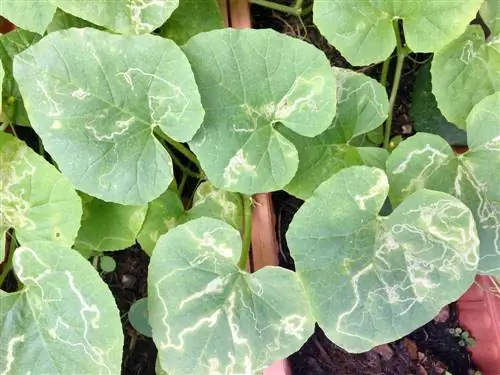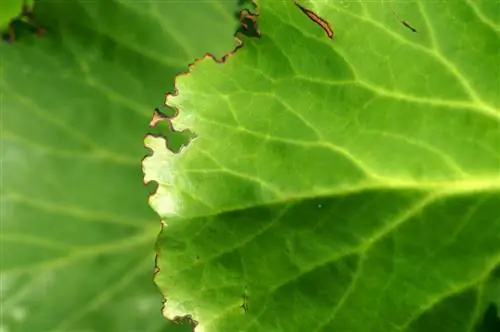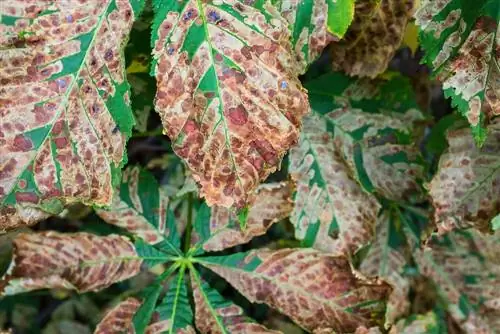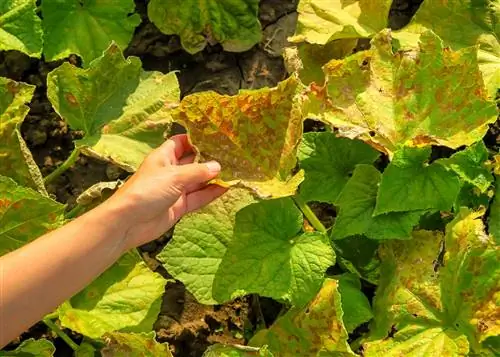- Author admin [email protected].
- Public 2023-12-16 16:46.
- Last modified 2025-06-01 06:02.
If the leaves or needles of thuja and other trees suddenly turn brown, the leaf miner may be behind it. In this article you will learn how to get rid of the stubborn pest.
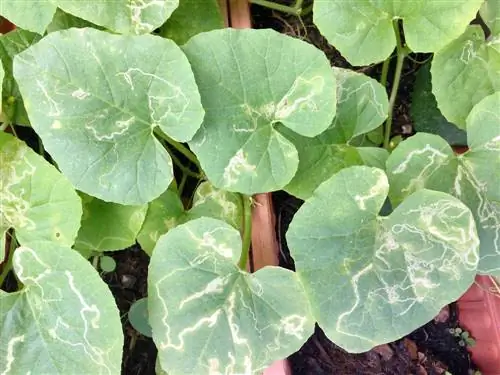
How to combat leaf miners?
To effectively combat leaf miners, you should remove infected leaves, hang pheromone traps, spray the plants regularly with nettle manure or neem, prune, carefully dispose of autumn leaves and attract predators such as birds and parasitic wasps.
- The leaf miner is a tiny, inconspicuous butterfly.
- It lives primarily in deciduous trees and its caterpillars eat their way through the leaves.
- These turn brown and eventually fall off.
- Leaf miners are controlled with scissors and sprays as well as with preventative measures.
What are leaf miners?
Leaf leaf miners are very small, quite inconspicuous butterflies that have only appeared in Europe since the 1970s. The Thuja leaf miner in particular - one of around 230 European species - has been feared by hedge owners since the 1990s because of its invasive presence. The different species are usually specialized on certain host plants, after which they are named. The butterflies live in trees and other woody plants, and their caterpillars in particular cause a lot of damage. The animals live as so-called miners, i.e. H. They primarily eat through the leaves of the plants and thus damage them.
This is what the pest looks like
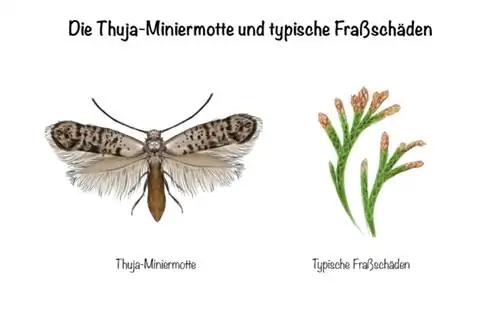
The external appearance of leaf miners and their caterpillars differs depending on the species. However, all varieties have certain characteristics in common:
- very small butterflies with a small wingspan between five and nine millimeters
- only rarely slightly larger
- mostly flesh to olive colored body
- other colors also possible
- fringed wings
- pronounced proboscis
- Caterpillars noticeably flat and, depending on age, up to approx. 5 millimeters long
- Appearance of the caterpillars strongly depends on the respective larval stage
Knowledge of lifestyle important for efficient control
Most leaf miner species are active very early in the year and start flying around April. The pests overwinter as caterpillars or even adult butterflies in the fallen leaves or leaves remaining on the tree, but can also hide in the tree bark. The females lay up to 40 eggs, from which the larvae hatch within just two to three weeks. These immediately begin their work of destruction and drill into the inside of the leaves in order to eat tunnels into the tissue. After a total of five larval stages, the caterpillars pupate in these tunnels, which can usually be seen with the naked eye.
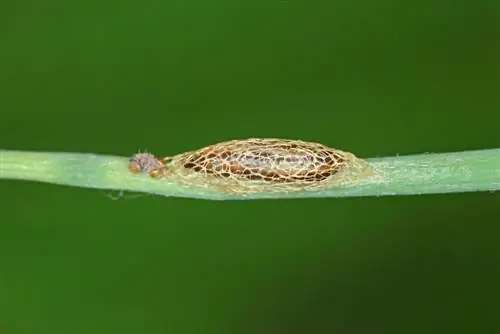
The leaf miner pupae are easy to see
Depending on the species and weather, up to four generations of leaf miners develop each year, which are not limited to just one tree. Quite the opposite: If it is warm and dry, all neighboring trees are also affected in no time due to the rapid development. For this reason, it is important to act as early as possible if an infestation is suspected. This is the only way you can prevent the plague from spreading. If you or your neighborhood have ever had leaf miners, you should take appropriate precautionary measures. Above all, this includes always clearing away and disposing of autumn leaves.
Excursus
This butterfly damages chestnut
If chestnuts get brown leaves early in the year, the horse chestnut leaf miner (Cameraria ohridella) is often behind it. This pest has also only appeared in Central Europe for a few decades, but has quickly developed into a problem for the population of white-flowering horse chestnuts. As a rule, only this variety of deciduous tree is attacked; red-flowering varieties are of no interest to the butterfly. The horse chestnut leaf miner is not closely related to the native members of its family and has a completely different appearance with its orange-brown color. However, the same rules apply to them when it comes to control methods.
Damage - How to recognize a leaf miner infestation
Typically, infected plants quickly turn brown due to a leaf miner infestation. You can find out what other causes cause thuja to turn brown in the following video.

The damage caused by the caterpillars' feeding activities is very quickly visible due to their often massive occurrence. However, the majority of this is just visual damage: the affected tree looks unsightly, but is not directly at risk. Trees damaged by leaf miners rarely die because the butterflies prefer to populate larger and therefore more resilient specimens. Typically the damage is shown by:
- an unsightly brown coloring of the leaves or needles even in early summer
- Mostly deciduous trees are affected, but some conifers (thuja) are also at risk
- This is often followed by premature leaf fall
- Heavily infected trees often limit their growth
- Reduction in the formation of flowers (especially in lilacs) or the formation of fruits (chestnut)
In some cases, trees infected with leaf miners often begin to bloom again in late summer or even autumn - namely when the tree has recovered from the infestation. On deciduous trees, new, he althy leaves form the following spring. Only conifers such as thuja look permanently unsightly because the brown needles do not turn green again even after the pest has been successfully combated.
These plants are particularly often attacked by leaf miners
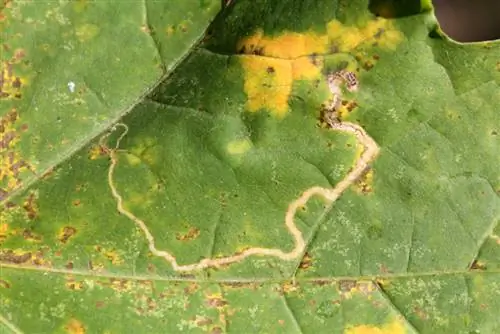
Maple leaves taste particularly good to leaf miners
The thujas (trees of life) and horse chestnuts, which are so popular for dense hedges, are particularly often attacked by the voracious leaf miners. These tree species are also at risk:
- Maple (Acer)
- Robinia or false acacia (Robinia pseudoacacia)
- Azaleas (Rhododendron molle and other species)
- Lilac (Syringa)
It also shows that the pests are increasingly conquering other host plants. Apparently the butterflies are not completely specialized, but can expand their range of prey. Therefore, pay particular attention to possible infestation on stone and pome fruit trees and deciduous trees in general. This is especially true if other trees in your garden - such as the Thuja hedge - are already infected.
Fighting leaf miners
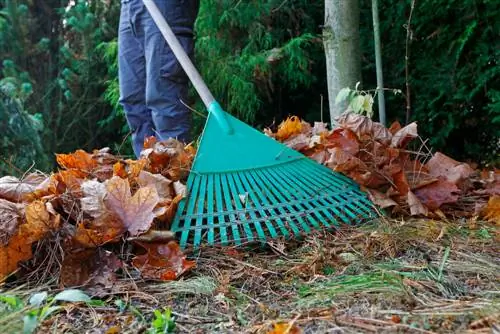
Infected leaves should be disposed of
Unfortunately, leaf miners are difficult to combat once you have the infestation on the tree. Therefore, preventive measures are even more important, especially collecting fallen leaves - this way you can prevent another plague the following year.
Pheromone traps
Pheromones are certain sexual attractants that female leaf miners use to attract males for mating. Special pheromone traps are available commercially (€20.00 on Amazon) that you can hang in the trees and then capture the male butterflies. The animals get stuck on the glue attached to the trap and can no longer escape. Although attractant traps reduce the infestation pressure, as fewer male moths also mean fewer fertilized females and therefore fewer caterpillars, they are not suitable for sole control. However, with their help you can determine whether there is a leaf miner infestation and how severe it is. Afterwards, you'd better take effective countermeasures.
Tip
Hang the pheromone traps in endangered trees as early as April and leave them there until mid or even the end of October if possible.
Spraying with nettle manure
“Why do you need chemical sprays when you can make completely non-toxic plant manure yourself cheaply?”
Spraying with nettle manure has also been shown to be effective against the leaf miner, although not in the case of an acute infestation. As a preventive measure, spray endangered trees regularly, starting in April at the latest and continuing until late autumn. The method is therefore quite complex and sometimes difficult to implement for large trees - a horse chestnut can grow up to 30 meters high. However, spraying is practical for smaller trees, such as thujas, lilacs or rhododendrons.
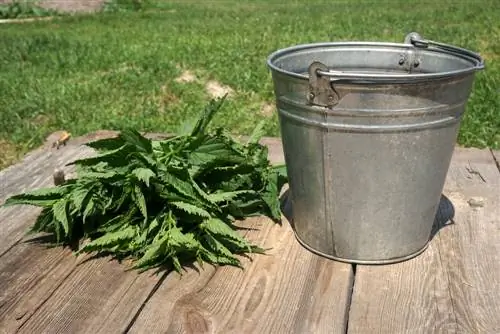
Stinging nettle manure is a cheap, environmentally friendly method of combating leaf miners
How to prepare the nettle manure:
- Collect a kilogram of nettles.
- These should not bloom if possible.
- Otherwise you can use the whole plant including leaves and stems.
- Crush the herb, as the active ingredients will then dissolve better.
- Put the plant material in a plastic bucket.
- Do not use a metal container, this will lead to undesirable chemical reactions.
- Pour ten liters of rainwater on it.
- Add a handful of rock dust (to prevent the unpleasant smell that develops later).
- Place the bucket in partial shade.
- Cover it with a mosquito net, beach mat or similar.
- After about eight to ten days, the manure is ready and can be used.
Spray the trees every two weeks between March / April and September / October. When filled into canisters, the finished manure lasts for about a year.
Spraying with Neem
A spray with the natural insecticide neem (or neem), an agent obtained from the Indian neem tree (Azadirachta indica), also has a repellent effect on the caterpillars of the leaf miner and damages their development. However, neem products are quite expensive, which is why regular treatment of a large tree no longer represents a reasonable cost-benefit ratio - especially since neem also has effects on other insects. Here, similar to home-made nettle manure, it is primarily used on smaller trees.
Excursus
Are there any approved sprays against leaf miners for home and hobby gardens?
For hobby gardeners, the selection of effective plant protection products is very limited, as their use in home or allotment gardens is either prohibited or only possible with appropriate proof of expertise. This also applies to the often recommended product Calypso from the manufacturer Bayer. The other anti-miner moth remedies available on the market and approved for hobby gardening all work on the basis of natural active ingredients, such as garlic or neem.
Regular pruning
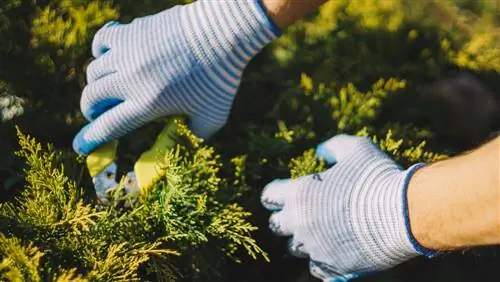
Regular pruning protects the thuja from leaf miner infestation
Together with a spray, regular pruning, especially of threatened thuja hedges, is an effective prevention against leaf miner infestation. You should proceed as follows:
- Cut back Thujen in early spring
- begin at the same time as the spraying (e.g. with nettle manure)
- cut back again in July
- at the same time further spraying with nettle manure
Do not dispose of the clippings in the compost, but rather with household waste or burn them.
Collect and dispose of autumn leaves
Another very effective remedy against annoying leaf miners is this: carefully collecting and disposing of fallen leaves, especially autumn leaves. Be very consistent in this regard so that no leaf is left lying around and the animals that hibernate in it can possibly cause another plague the following year. Under no circumstances should you dispose of the leaves in the compost, as the moths will continue to develop here and will still hatch next spring. Instead, throw the leaves in the trash or, better yet, burn them. Of course, the latter is only possible if burning garden waste is permitted in your residential area. This method is particularly useful for infected horse chestnuts and other large deciduous trees.
Tip
If you would like to plant a chestnut in your garden, choose the scarlet horse chestnut (Aesculus x carnea “Briotii”), which is resistant to leaf miners. Experience has shown that this is spurned by the little animals.
Settle predators

Birds like to eat leaf miners
Like so many other pests, the leaf miner also has natural enemies who literally like to eat the butterfly and thus decimate the population without any further action on your part. These include, in particular, some songbirds such as titmice, which you can attract to your garden with a few nesting boxes hung in endangered trees and strategically placed feeding stations. Please note that the feathered pest killers will only feel comfortable with you if you make your garden bird-friendly:
- no use of chemical pesticides (especially insecticides!)
- these destroy the birds' food source and also poison them
- a dense stand of trees and other woody plants, preferably native species
- dense hedges, ideal for breeding
- Feeding places, not just in winter
- several nesting boxes
In addition to birds, parasitic wasps are also natural opponents of leaf miners. You can buy these - completely harmless - beneficial insects from specialist retailers and plant them specifically in endangered trees. The advantage of such a measure is that parasitic wasps are also effective against a whole range of other garden pests.
Further measures
Since leaf miners often hide in the bark of trees over the winter months, you should surround the trunks of endangered trees with rings of glue or coat them with a mixture of wallpaper paste and lime in early autumn. In this way, the animals cannot retreat into the bark, which means that another place of retreat remains blocked.
Frequently asked questions
In which season are leaf miners particularly active?
Leaf leaf miners are mainly active at two times a year, which is why you should adapt your control strategy (spraying and cutting) accordingly. The main peaks in moth activity are in early spring, usually in April, and again in July / August. But in the meantime, additional generations can fly out if the weather is suitable, which is why regular spraying with biological agents is so important.
What to do if there are leaf miners in the apartment?
In rare cases, for example when an infected tree is near a window, leaf miners can also get into the house or apartment and cause havoc on houseplants. Therefore, keep doors and windows closed or provide them with an insect screen as soon as you suspect an infestation. However, the leaf miners do not eat food such as flour etc. as this does not correspond to their natural diet. If you find moths in your supplies, they are definitely so-called flour moths (Ephestia kuehniella), which look very similar to leaf miners.
Tip
If you have chickens, you should let them run freely in the ornamental garden or orchard. The busy animals scratch and peck all day long for beetles and larvae lying on the ground, which is why they also kill the larvae of the leaf miner (as well as other pests) found in fallen leaves.

